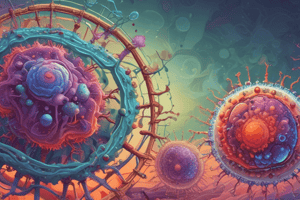Podcast
Questions and Answers
What is a virus?
What is a virus?
A virus is a tiny nonliving particle that enters and then reproduces inside a living cell.
Viruses have the characteristics essential for life.
Viruses have the characteristics essential for life.
False (B)
A virus is a cell that uses its own energy to grow and respond to its surroundings.
A virus is a cell that uses its own energy to grow and respond to its surroundings.
False (B)
Viruses can make food, take in food, or produce waste.
Viruses can make food, take in food, or produce waste.
The only way a virus is like an organism is that it can multiply only when inside a cell.
The only way a virus is like an organism is that it can multiply only when inside a cell.
Where does a virus multiply?
Where does a virus multiply?
How does a virus act?
How does a virus act?
Viruses destroy the cells in which they multiply.
Viruses destroy the cells in which they multiply.
What is a bacteriophage?
What is a bacteriophage?
Flashcards
What is a virus?
What is a virus?
A tiny, nonliving particle that enters and reproduces inside a living cell.
Virus Multiplication
Virus Multiplication
A virus can only multiply inside a host cell; it acts as a parasite.
What is a bacteriophage?
What is a bacteriophage?
A virus that infects and destroys bacteria.
What is a Host?
What is a Host?
Signup and view all the flashcards
Virus as a Parasite
Virus as a Parasite
Signup and view all the flashcards
Virus Cell Destruction
Virus Cell Destruction
Signup and view all the flashcards
Study Notes
Basic Characteristics of Viruses
- Viruses are extremely small, nonliving particles that invade living cells to reproduce.
- They lack all characteristics necessary for life, distinguishing them from cellular organisms.
- Viruses are acellular; they do not use energy to grow or respond to environmental stimuli.
- They cannot perform essential life functions: making food, consuming food, or excreting waste.
- The primary similarity between viruses and living organisms is their ability to replicate, but only within a host cell.
- Viruses multiply inside a host organism, which provides the energy needed for their reproduction.
- Acting as parasites, viruses reside in hosts and often cause harm, making them detrimental to the host's health.
- The replication process of viruses typically leads to the destruction of the host cells.
- Bacteriophages specifically target and infect bacterial cells, showcasing a unique interaction between viruses and bacteria.
Studying That Suits You
Use AI to generate personalized quizzes and flashcards to suit your learning preferences.




